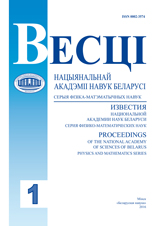
Scientific and practical peer-reviewed journal
The scientific journal "Proceedings of the National Academy of Sciences of Belarus. Physics and Mathematics Series" ("Vescì Nacyânalʹnaj akadèmìì navuk Belarusì. Seryâ fìzìka-matèmatyčnyh navuk") is registered on May 18, 2009 by the Ministry of Information of the Republic of Belarus in the State Registry of Mass Media, reg. No. 392. Periodicity is 4 issues per annum. The area of distribution is The Republic of Belarus and foreign countries (by subscription and by retail). The Journal publishes the results of research, carried out by The National Academy of Sciences and other Belarusian and foreign scientific institutions or universities in the fields of theoretical physics, laser optics & spectroscopy, solid-state & semiconductors physics, nuclear physics, algebra, differential equations, mathematical analysis, computational mathematics, mathematical statistics, and informatics. In the column "Scientists of Belarus", the Journal celebrates anniversaries of the famous scientists and acquaints readers with their biography and works.
The Journal is included in The List of Journals for Publication of the Results of Dissertation Research in the Republic of Belarus and in the database of Russian Science Citation Index (RSCI), as well as to international databases such as Scopus, MathSciNet, Сhemical Abstracts. One can find contents of the Journal’s issues, as well as abstracts of published articles, at the websites of the publisher (http://belnauka.by) and of the NAS of Belarus (http://nasb.gov.by/eng).
Number of pages: 128.
The Journal is included in the Subscription Catalogue of the Republic of Belarus: the subscription indices are 74846 (for individuals) and 748462 (for institutions).








































